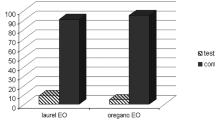Abstract
In laboratory and field tests, water extracts from plant foliage deterred oviposition byHeliothis virescens (F.). A maximum reduction of 93% was attained in laboratory oviposition cages. When females were allowed free choice of treated or untreated tobacco plants in field cage and field tests, maximum reductions in oviposition were 71 and 83%, respectively.
Similar content being viewed by others
References
Alfaro, R.I., Pierce, H.D., Jr., Borden, J.H., andOehlschlager, A.C. 1981. Insect feeding and oviposition deterrents from western red cedar foliage.J. Chem. Ecol. 7:39–48.
Anonymous. Undated. Weeds of the Southern United States. Florida Cooperative Extension Service. Gainesville, Florida. 42 pp.
Altieri, M.A. 1981. Weeds may augment biological control of insects.Calif. Agric. 35:22–24.
Boddé, T. 1982. Entomologists probe chemical defenses and natural enemies.BioScience 32:308–311.
Chapman, R.F., Bernays, E.A., andSimpson, S.J. 1981. Attraction and repulsion of the aphid,Cavariella aegopodii, by plant odors.J. Chem. Ecol. 7:881–888.
Fernald, M.L. 1950. Gray's Manual of Botany. American Book Company, New York. 1632 pp.
Gross, H.R., Jr., Young, J.R., andWiseman, B.R. 1982. Relative susceptibility of a summer planted dent and tropical flint corn variety to whorl-stage damage by the fall armyworm,Spodoptera frugiperda (J.E. Smith).J. Econ. Entomol. 75:1153–1156.
Jermy, T. 1966. Feeding inhibitors and food preference in chewing phytophagous insects.Entomol. Exp. Appl. 9:1–12.
Kubo, I., Taniguchi, M.M., Chapya, A., andTsujimoto, K. 1980. An insect antifeedant and antimicrobial agent fromPlumbago capensis.J. Med. Plant Res. 0 (Suppl.):185–187.
Ladd, T.L., Jr., Jacobson, M., andBuriff, C.R. 1978. Japanese beetles: Extracts from neem tree seeds as feeding deterrents.J. Econ. Entomol. 71:810–813.
Nettles, W.C., Jr. 1980. AdultEucelatoria sp.: Response to volatiles from cotton and okra plants and from larvae ofHeliothis virescens, Spodoptera eridania, andEstigmene acrea.Environ. Entomol. 9:759–763.
Orsenigo, J.R. Florida Weeds—Part II. 1977. Florida Cooperative Extension Service Circular 419. Gainesville, Florida. 19 pp.
Perkins, K.D., andPayne, W.W. Undated. Guide to the Poisonous and Irritant Plants of Florida. Florida Cooperative Extension Service.
Renwick, J.A.A., andRadke, C.D. 1981. Host plant constituents as oviposition deterrents for the cabbage looper,Trichoplusia ni.Entomol. Exp. Appl. 30:201–204.
Rose, J. 1972. Herbs and Things. Grosset and Dunlap Workman Publishing Company, New York. 323 pp.
Saxena, K.N., andBasit, A. 1982. Inhibition of oviposition by volatiles of certain plants and chemicals in the leafhopperAmrasca devastans (Distant).J. Chem. Ecol. 8:329–338.
Trial, H., Jr., andDimond, J.B. 1979. Emodin in buckthorn: A feeding deterrent to phytophagous insects.Can. Entomol. 111:207–212.
Wallace, J.W., andMansell, R.L. 1976. Biochemical Interaction between Plants and Insects, Vol. 10 (Recent Advances in Phytochemistry). Plenum Press, New York. 425 pp.
Yepsen, R.B., Jr. 1977. Organic Plant Protection. Rodale Press, Inc., Emmaus, Pennsylvania. 688 pp.
Author information
Authors and Affiliations
Additional information
Lepidoptera: Noctuidae.
Mention of a commercial or proprietary product does not constitute an endorsement by the USDA.
Rights and permissions
About this article
Cite this article
Tingle, F.C., Mitchell, E.R. Aqueous extracts from indigenous plants as oviposition deterrents forHeliothis virescens (F.). J Chem Ecol 10, 101–113 (1984). https://doi.org/10.1007/BF00987647
Received:
Revised:
Issue Date:
DOI: https://doi.org/10.1007/BF00987647




